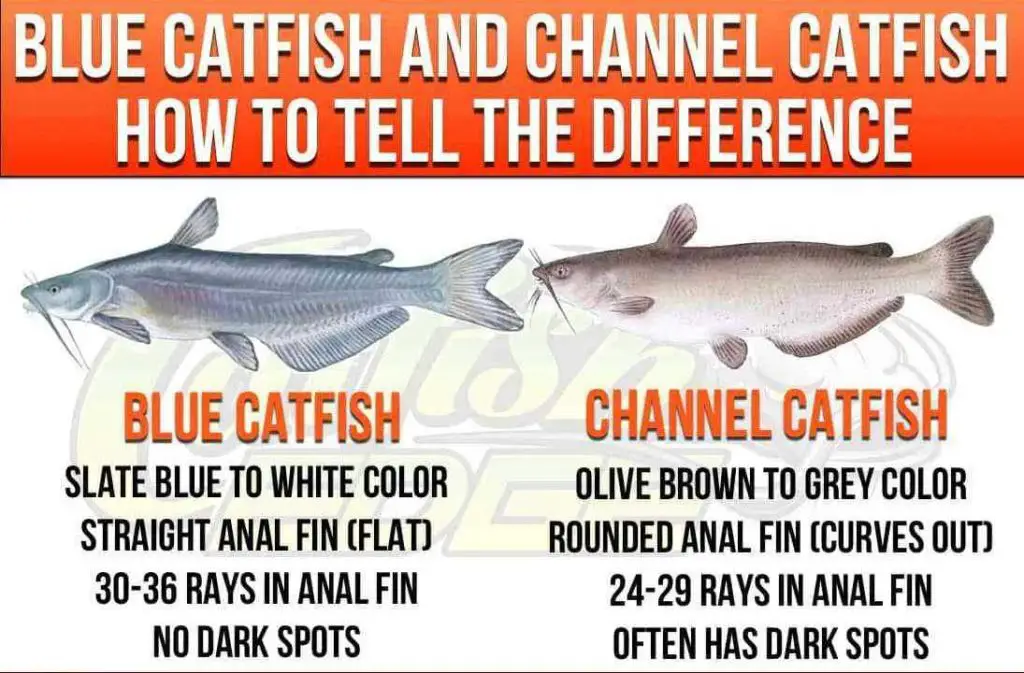The three main types of catfish species are the blue catfish, channel catfish, and flathead catfish. But there are many other catfish species like the cory catfish, pictus catfish, and oto catfish. Here’s everything you need to know about catfish.
Contents
Catfish Identification Chart
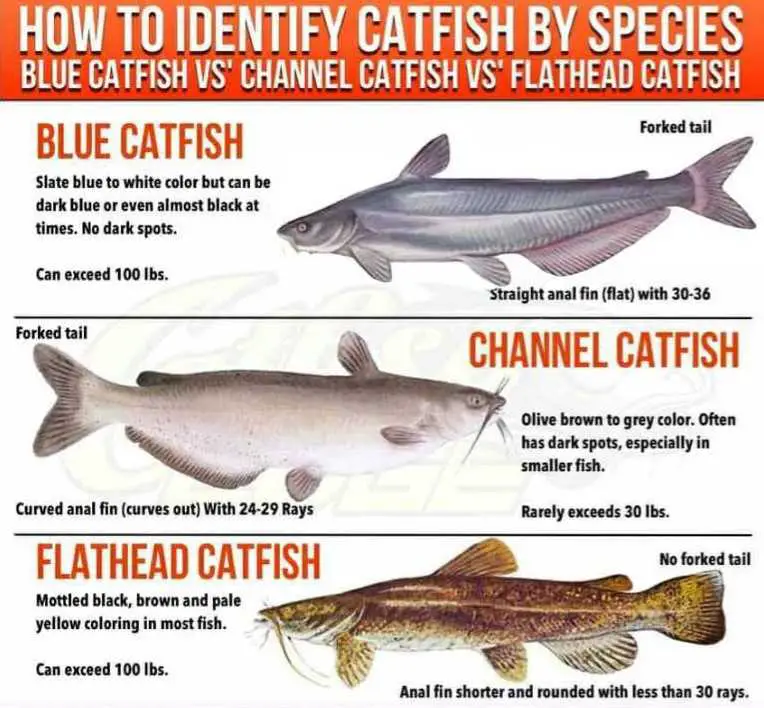
Invasive Catfish vs Non-Invasive Catfish Identification
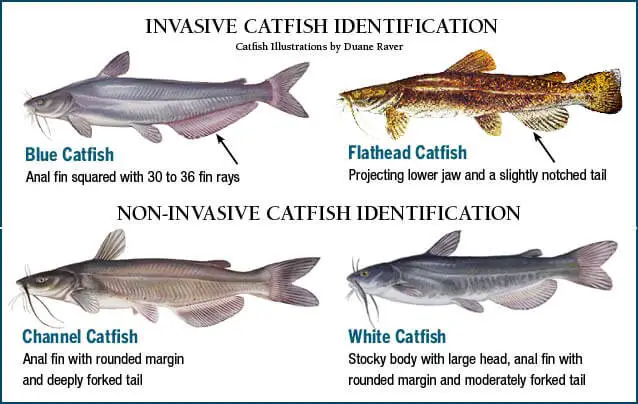
Blue Catfish vs Channel Catfish: How To Identify
Blue Catfish Identification:
- Slate blue to white coloring.
- Anal fin is flat (when laid flat it forms a straight line).
- The anal fin has between thirty and thirty-six rays.
Channel Catfish Identification:
- Olive brown to grey coloring
- Rounded anal fin (laid flat it curves out like a letter “c”)
- Twenty-four to twenty-nine rays in the anal fin
- Often has dark spots, but these spots can be absent in adult fish
The Different Types of Catfish
Our catfish species list: Here are pictures of different types of catfish and a brief description of their features, habitat, and habitat:
Blue Catfish
The blue catfish is sometimes misidentified as the channel catfish. But, blue catfish are large and have smooth skin. Their bodies are a slate blue color and they have whisker-like barbels around the mouth.
In North America, the blue catfish is the largest catfish species. It can grow to lengths of 5 feet and 5 inches and weigh up to 150+ pounds. The average lifespan of the blue catfish is 20 years.

Blue catfish live in main channels, tributaries, and impoundments of major river systems. These kinds of catfish travel upstream in search of cooler temperatures in the summer and travel down south in the winter to get to warmer temperatures.
Blue catfish are freshwater catfish species that are native to Ohio, Missouri, and the Mississippi River. However, they are known to be in habitats as far south as Guatemala and Mexico.
Channel Catfish
Another of the most common types of freshwater catfish species is the channel catfish. It’s sometimes confused with the blue catfish but there are subtle differences that’ll help you identify them.
The average size channel catfish you could expect to find in most waterways is between 2 and 4 pounds. These types of catfish have a deeply forked tail similar to blue catfish but the coloring is much different (a distinguishing feature).

Channel catfish have an olive-brown to slate color and sometimes there are shades of blue and grey on the sides. Their bellies are white or silvery-white.
Channel catfish are the most common species found in North America. It is the official fish of Kansas, Missouri, Iowa, Nebraska, and Tennessee. Channel catfish are abundant in large streams, rivers, lakes, and reservoirs with low or moderate currents.
Flathead Catfish
Flathead catfish have flatheads, hence the name, and they are typically yellow in color. Hence their other name, yellow cat. The actual color is more olive-brown and other than the flathead, they look like other species of catfish. Flathead catfish prefer to live in the deep pools of creeks where the water is cloudy and currents are very slow.

Cory Catfish
Corydoras or the cory catfish are popular pet catfish for aquariums. These species of catfish grow up to 3 inches in length and have a relatively long lifespan of 20 years.
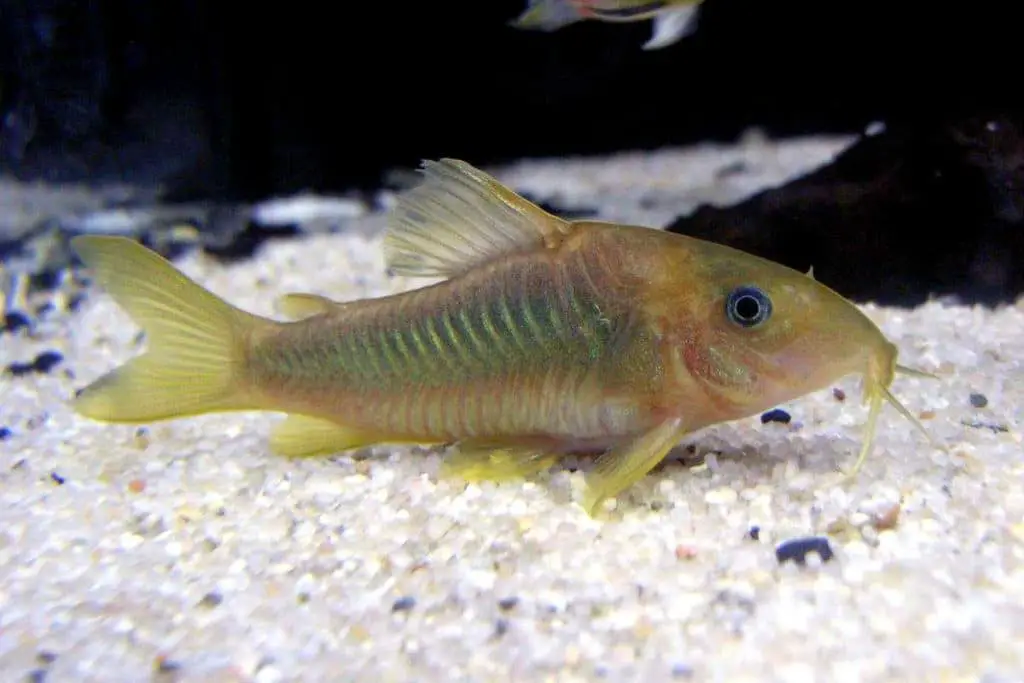
They are freshwater catfish, timid, non-violent, and easy to care for. They’re omnivorous so a mixture of a plant & meat-based diet is best when caring for cory catfish.
Glass Catfish
Glass catfish get their name because they are the only catfish species with transparent bodies. You can see the organs, bones, their entire insides if you look close enough. They live in slow-moving rivers and streams and their transparent body helps them to hide from predators. They are also known as ghost catfish and phantom catfish in the aquarium community.
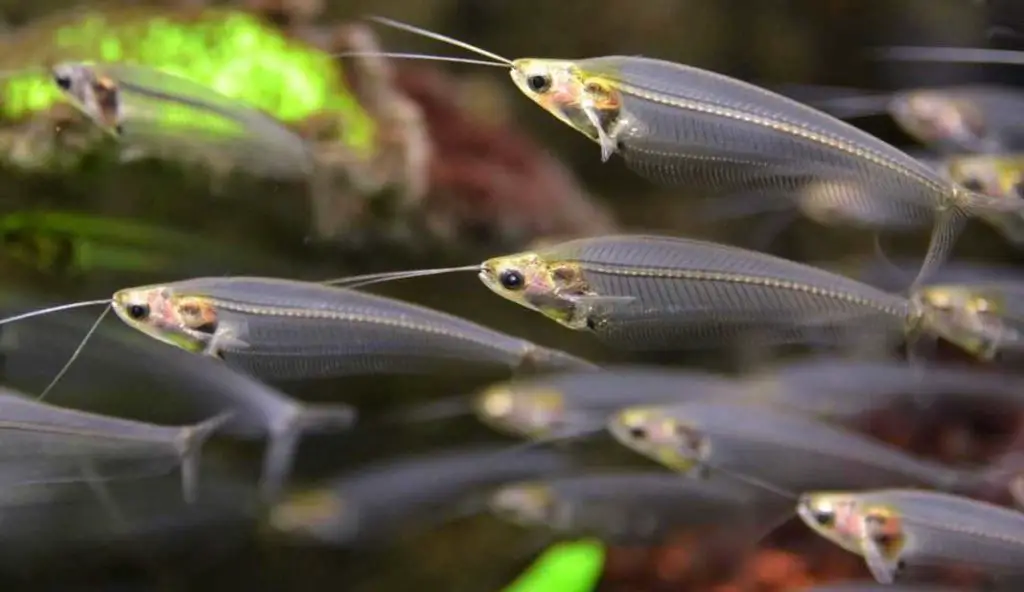
Pictus Catfish
The pictus catfish is native to the Orinoco and Amazon basins. These types of catfish are known for their long barbels. Pictus catfish grow up to 5 inches in length. They have a pale to gray body with a black-spotted pattern, a forked tail, a downturned mouth, and sharp spines on their dorsal fin.
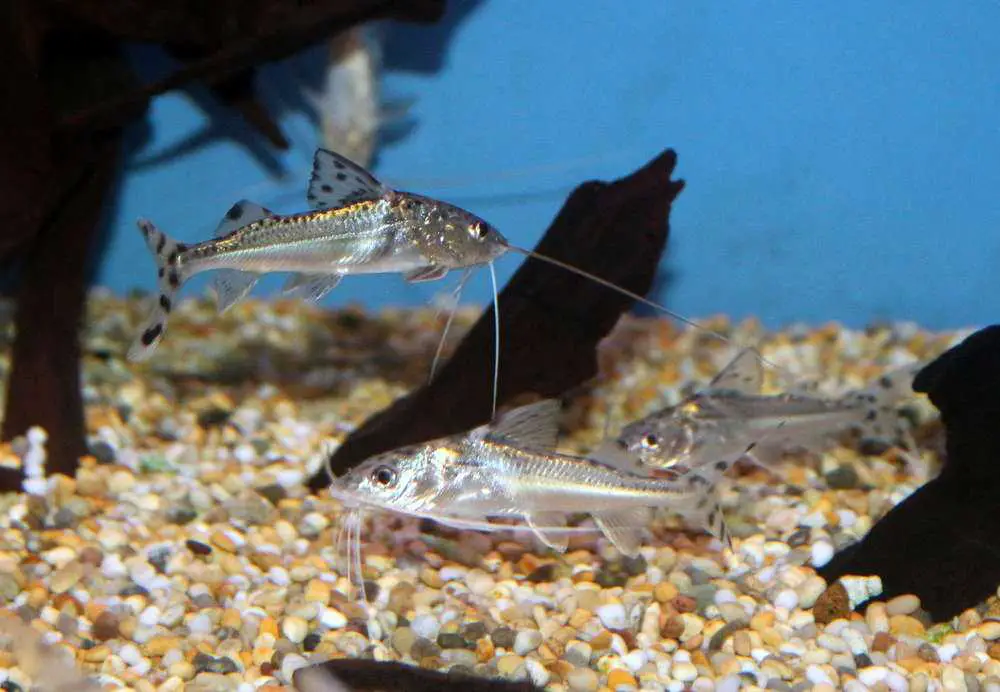
Upside Down Catfish
The upside-down catfish is perhaps the most peculiar fish on this catfish species list. These types of catfish are known to swim upside down. They also go by the names mochokid catfish, blotched upside-down catfish, or false upside-down catfish.
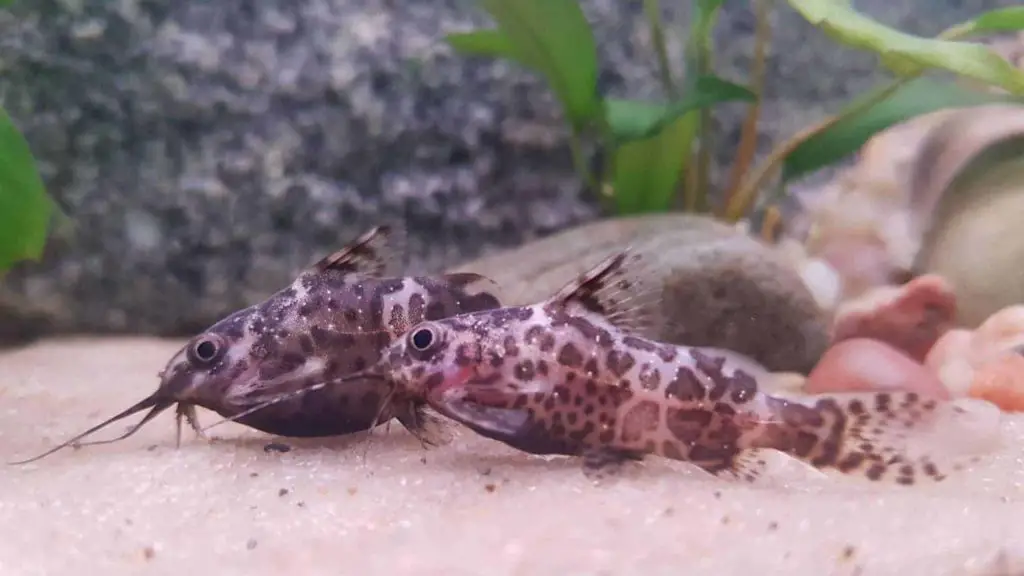
It is believed that they swim upside down because they often feed on the undersides of submerged branches and logs. Thus, swimming upside down makes it easier to feed. The upside-down catfish can grow up to an average of 3 to 4 inches in length. Their bodies are oftentimes light brown with dotted spots throughout.
Otocinclus Catfish
The otocinclus catfish are tiny scavenger fish that grow up to two inches in length. They are very peaceful fish and make great pets in a tank with other non-aggressive fish.
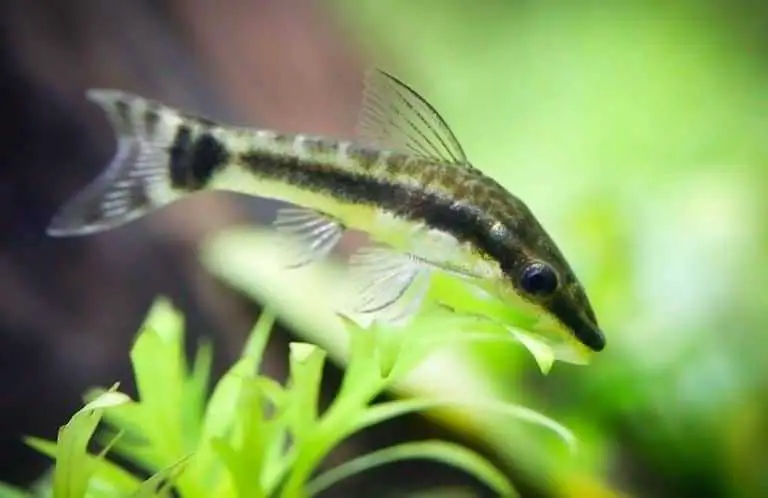
These catfish are good at cleaning the aquarium glass by eating the algae that grow on it or picking particles from plants in the aquarium.
Otocinclus is native to South America and is commonly called “dwarf suckers” or “otos”. They have rows of armor plating covering the body, as well as the underslung suckermouth.
Bristlenose Pleco
These types of catfish are also algae eaters which makes them a good addition to an aquarium as they help maintain the cleanliness of the tank. The bristlenose pleco can grow up to 5 inches in length and are gray, brown, and green in color, often with yellow or white spots.

They are nocturnal freshwater fish native to freshwater habitats in South America and Panama. They are common in the aquarium trade where they are known as bushynose or bristlenose catfish.
Striped Raphael Catfish
This species of catfish can live between 12 to 20 years and are known for making various sounds which persons liken to talking (fish-talk at least).
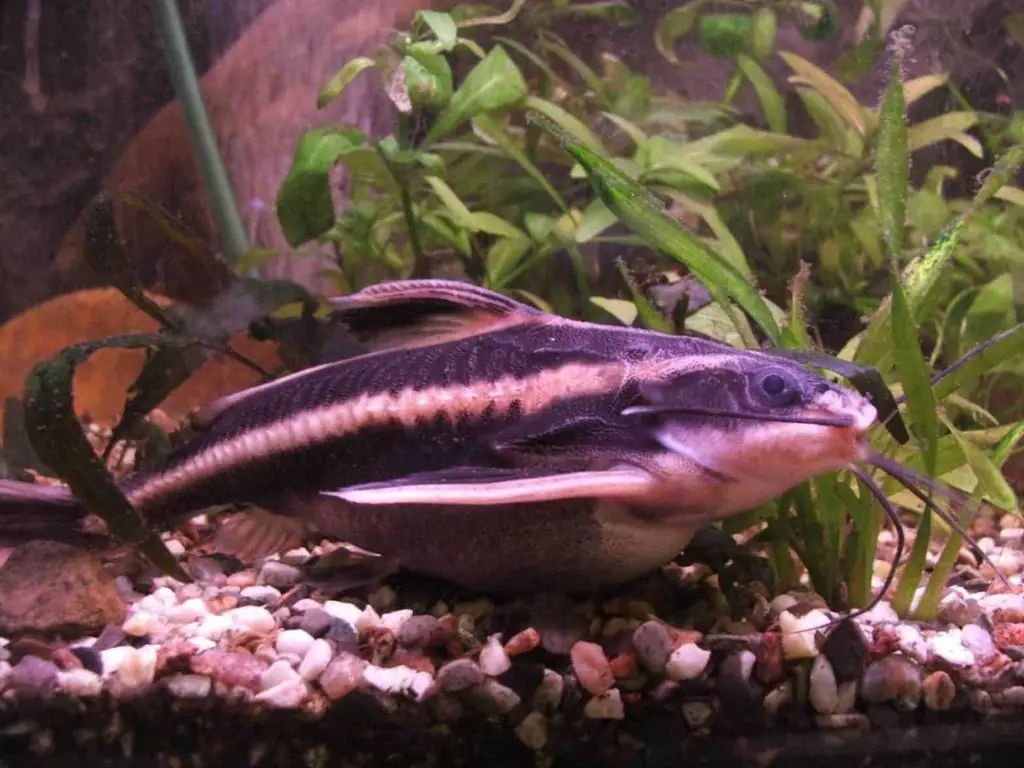
Striped Raphael catfish have large heads and an arrow-shaped body that’s striped in black and yellow. They typically scavenge the bottom of river beds for food.
The striped Raphael catfish is also be called Southern striped Raphael, talking catfish, chocolate doradid, chocolate catfish or thorny catfish. It is native to the Amazon, Paraguay–Paraná and lower Orinoco basins in South America.
Bumblebee Catfish
Bumblebee catfish grow up to 3.5 inches in length and can live for up to 5 years in ideal living conditions. They get their name because of the yellow and black stripes around their bodies that look like the colors of a bumblebee.
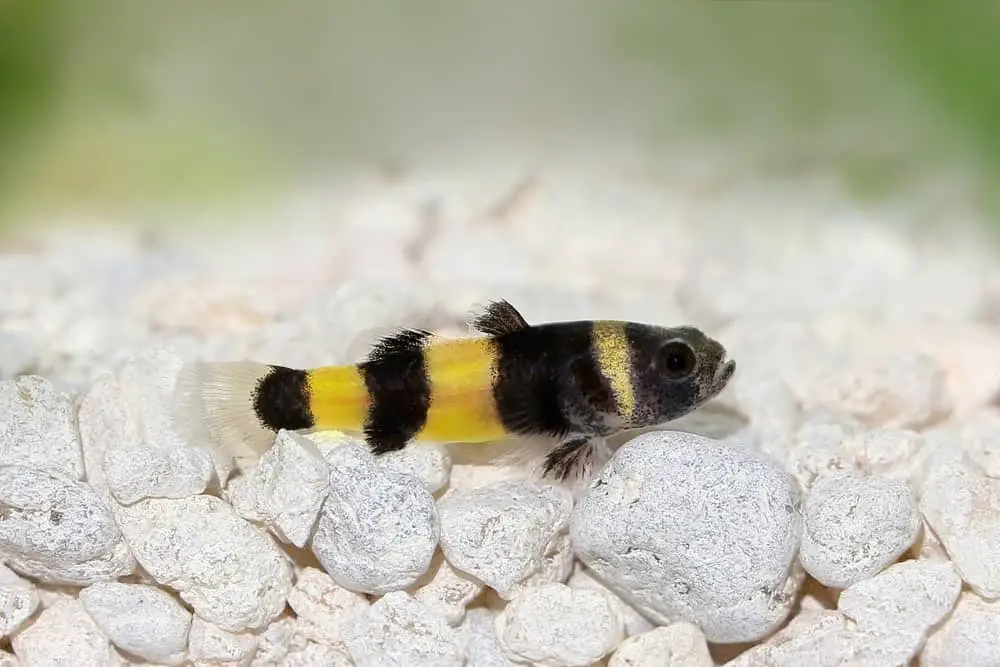
It is also known as the South American Bumblebee Catfish, a tropical fish that is native to Venezuela. They are found in clear, moderate to strong flowing waters of Venezuela, Colombia, Peru, the Amazon basin and other areas of northern South America.
Chinese Algae Eater
These types of catfish are another one of the catfish species that eat algae. The Chinese algae eater is also known as the lemon algae eater or suckerfish. These catfish can live up to 10 years and can grow up to a length of 1 inch. They have a golden hue with black spots over their body.

It is a freshwater fish native to large parts of Southeast Asia. It’s caught both for food as well as to keep as a pet. Other common names include honey sucker, sucking loach, Chinese algae eater, and Siamese algae eater; the FAO-endorsed common name is Siamese algae eater.
Wels Catfish
The average wels catfish can grow up to 5 feet long and can weigh up to 50 pounds. They are the only types of catfish that are native to Europe. It’s also one of the few species of catfish that change color depending on their environment.
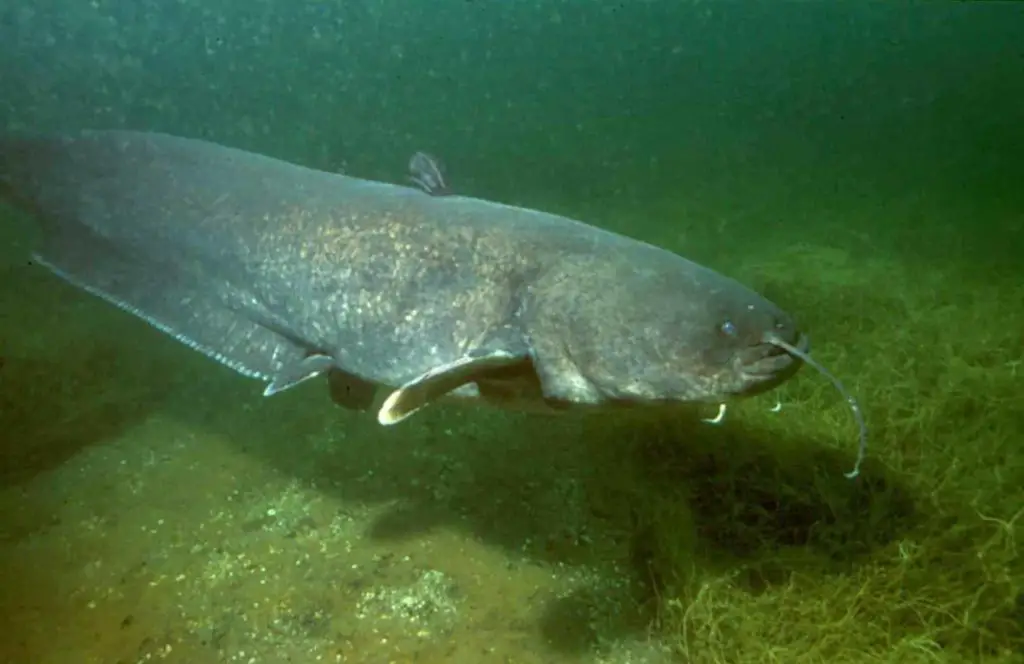
Their skin color changes to a black hue in clear water while muddy water turns them to a greenish-brown color. The wels catfish, also called sheatfish, is a large species of catfish native to wide areas of central, southern, and eastern Europe, in the basins of the Baltic, Black, and Caspian Seas.
Iridescent Shark
Iridescent sharks, also known as the siamese shark or sutchi catfish, are a species of catfish native to Asia. It’s not a shark but the catfish looks like a miniature shark hence the name.
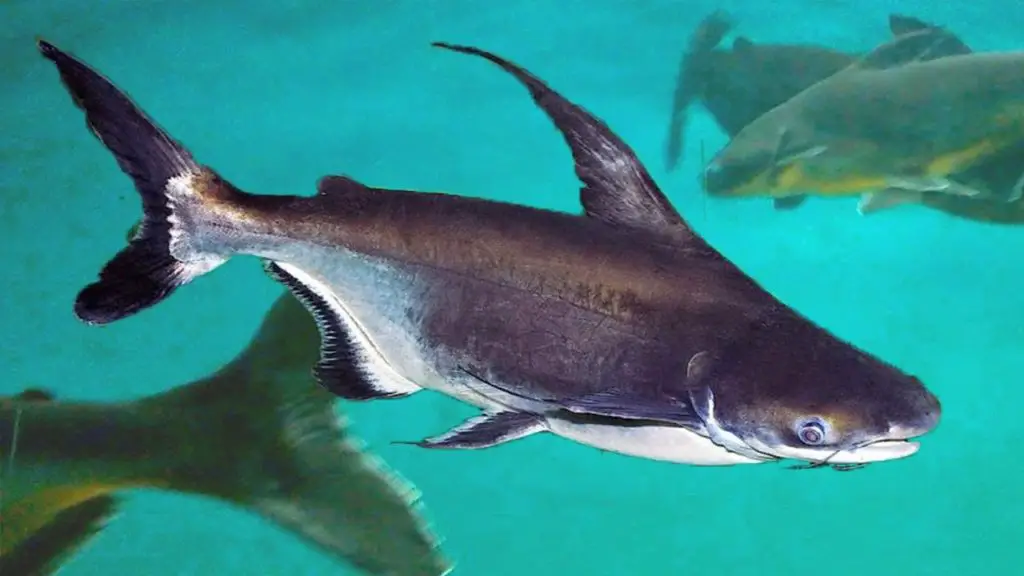
If given enough room and fed adequately, Iridescent sharks can reach 3.3 ft in length. In most home aquariums, the lack of space hinders their growth. Thus, most iridescent sharks kept in home aquariums grow to 6 to 12 inches in length and may die prematurely.
Armored Catfish
Armored Catfish is the name given to a group of catfish species that have bony plates covering their bodies and suckermouths. Members of this family of catfish include the oto catfish, pleco, and bristlenose catfish.
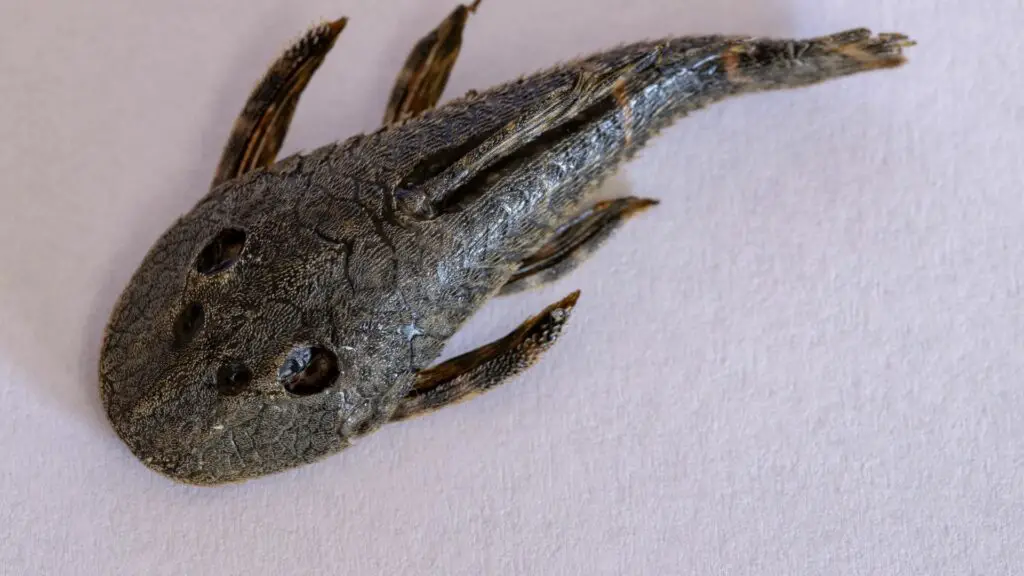
African Catfish
Clarias species are identified by their long-based dorsal and anal fins, which give them an eel-like appearance. These catfish have slender bodies, a flat, bony head, and a broad, terminal mouth with four pairs of barbels. It is the most common type of catfish in Nigeria.

Clarias also have a large, accessory breathing organ composed of modified gill arches. These catfish can live on land for long periods of time They are also known as the walking catfish.
Synodontis Catfish
Synodontis are also known as squeakers, due to their ability to make sounds through their pectoral fin spines when touched or disturbed.
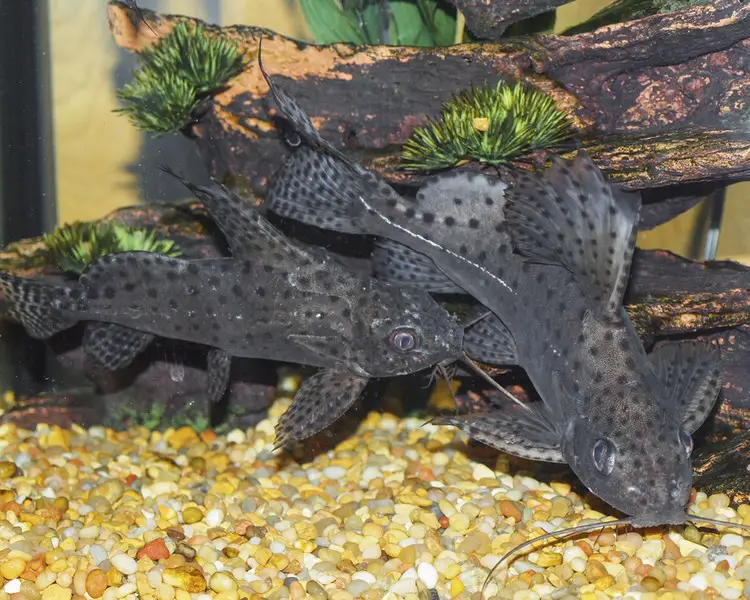
They are freshwater catfish that are most commonly found throughout Africa, occurring mostly in Central and West Africa.
Siluridae Catfish
These catfish do not have spines before their dorsal fins or adipose fins, and their pelvic fins are either small or absent. The anal fin base is usually very long.
The largest species in this family are Silurus glanis, the Wels catfish (see above), which can grow to lengths of over 9.8 ft and weigh over 300 lbs.
Shark Catfish
Shark catfishes are found in fresh and brackish waters across southern Asia. One of the largest known freshwater fish is the Mekong giant catfish, a type of shark catfish.
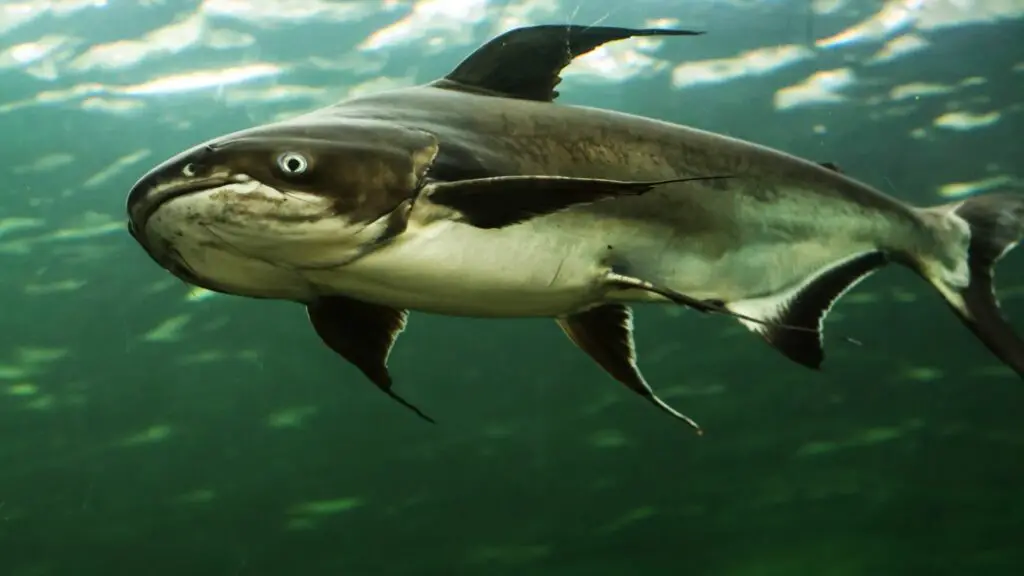
Bullhead Catfish
The three common types of bullhead catfish found in waters of the United States are the black bullhead, the brown bullhead, and the yellow bullhead.

The species known as bullheads can be distinguished from channel catfish and blue catfish by their squared tailfins, rather than forked.
References
- The “Big Three” Types Of Catfish (and How To Identify Them) – Catfish Species Essentials – Video – YouTube
- Catfish – Wikipedia
- How to identify catfish – flathead, blue, channel, white catfish, bullhead and other species – Video – YouTube
- Giant Catfish May Be World’s Largest Freshwater Fish – National Geographic
- Blue catfish – Wikipedia
- Monster Blue Catfish Trip!!! 356 lbs of catfish in 8 hrs. – Video – YouTube
- Channel catfish – Wikipedia
- Flathead catfish – Wikipedia
- Fish Species in Lake Havasu – Go Lake Havasu
- Catching Giant Flathead Catfish on the Tennessee River – Video – YouTube
- Cory catfish – Wikipedia
- Popular types of tropical fish to keep as pets – Collegian News
- Cory Catfish: Amazing Fish – Video – YouTube
- Ghost catfish – Wikipedia
- Popular types of freshwater aquarium fish – Collegian News
- Fish Focus – Glass Catfish – Video – YouTube
- Pictus catfish – Wikipedia
- All catfish species inventory – Sabaj, M. H., J. W. Armbruster, C. J. Ferraris, Jr., J. P. Friel, J. G. Lundberg and L. M. Page (eds.). 2003-2006. The All Catfish Species Inventory.
- “Giant Baghair caught in Jamuna” in The Daily Star (Bangladesh), 12 May 2009
- Skelton, Paul H. and Teugels, Guy G. 1992. Ichthyological Bulletin; No. 56: Neotype description for the African catfish Clarias Gariepinus (Burchell, 1822) (Pisces: Siluroidei: Clariidae). J.L.B. Smith Institute of Ichthyology, Rhodes University, Grahamstown, South Africa
- Catfish Varieties. Animal-World
- “Schoolgirl nets 9ft monster fish”. The Daily Telegraph.
- Species Profile # 11: The Pictus Catfish (Pimelodus pictus) – Video – YouTube
- Upside-down catfish – Wikipedia
- Upside-Down Catfish Doesn’t Care What You Think – Video – YouTube
- Otocinclus Catfish Care Guide – Aquarium Co-op
- Otto Fish – Wikipedia
- Otocinclus Catfish Care Guide – Otocinclus vittatus – Best nano algae eater. Great for brown algae. – Video – YouTube
- Bristlenose catfish – Wikipedia
- Bristlenose Pleco Care and Breeding – Video – YouTube
- Raphael catfish – Wikipedia
- Striped Raphael Catfish (Platydoras armatulus) Feeding humbugs!! – Video – YouTube
- Bumblebee Catfish – Size, Lifespan, Tank Mates, Breeding – Fish Lore
- South American Bumble Bee Catfish – Video – YouTube
- Chinese Algae Eater – Wikipedia
- Chinese Algae Eater in my 55g Angelfish tank. – Video – YouTube
- Wels Catfish – River Monsters Wiki
- Wels catfish – Wikipedia
- Encounter with a Bold Wels Catfish – River Monsters – Video – YouTube
- Iridescent Shark in Freswater Aquarium – Video – YouTube
- Iridescent Shark Care – Size, Life Span, Tank Mates, Breeding – Fish Lore
- Iridescent shark – Wikipedia
- Catfish – Loricariidae – Mongabay
- Planet Catfish Catalogue of loricariid catfishes
- Species in Clarias – Fish Identification
- Ng, H. H.; Dang, K. H. & Nguyen, V. T. (2011). “Clarias gracilentus, a new walking catfish (Teleostei: Clariidae) from Vietnam and Cambodia” (PDF). Zootaxa. 2823: 61–68
- Friel, John P.; Vigliotta, Thomas R. (2006). “Synodontis acanthoperca, a new species from the Ogôoué River system, Gabon with comments on spiny ornamentation and sexual dimorphism in mochokid catfishes (Siluriformes: Mochokidae)”(PDF). Zootaxa. 1125: 45–56.
- “Siluridae” – FishBase.
- “Pangasiidae” – FishBase.
- Ferraris, Carl J., Jr. (2007). “Checklist of catfishes, recent and fossil (Osteichthyes: Siluriformes), and catalogue of siluriform primary types” (PDF). Zootaxa. 1418: 1–628.
- Bullhead Catfish | Fish Facts | Fisherman’s Outfitter
- How many types of catfish are there in the world?
- How to identify catfish – flathead, blue, channel, white catfish, bullhead and other species
- Catfish Farming Business in Nigeria

